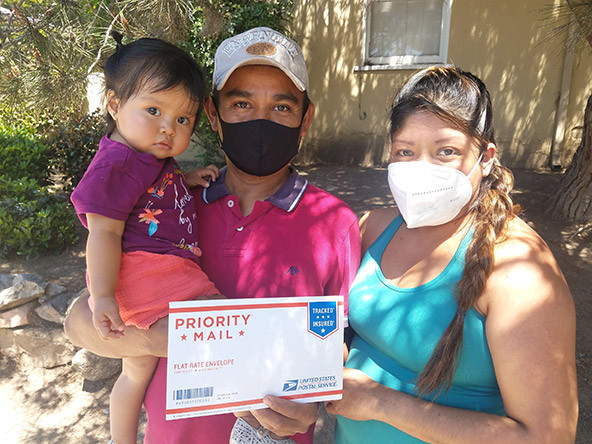 California families left out of the COVID-19 federal stimulus initiative received cash assistance from California’s Immigrant Resilience Fund. (Photo courtesy of Alliance San Diego)
California families left out of the COVID-19 federal stimulus initiative received cash assistance from California’s Immigrant Resilience Fund. (Photo courtesy of Alliance San Diego)
Last year, when Governor Gavin Newsom appointed me California’s first senior advisor on social innovation to lead public-private partnerships, he already knew it was a moment for collaboration like never before. Although California had experienced decades of prosperity, not all Californians had benefited from the state’s success, and we needed to rethink our approach to build a California for all.
In the face of the COVID-19 pandemic, business, philanthropic, and nonprofit organizations have partnered with government in unprecedented ways to support Californians. The state’s recently released Social Innovation Impact Report shows that under Governor Newsom’s leadership, our office has led public-partnerships totaling $3.9 billion in corporate and philanthropic funding, in coordination with $1.3 billion in public funding. We have created far more social impact than we would have by working alone. And while public-private partnerships are not new, California is the first state in the country to lead cross-sector collaborations at such a large scale.

When the public, private, and philanthropic sectors partner, everyone benefits. In California, our partnerships are addressing problems including the state’s homelessness crisis, supporting California’s undocumented immigrants, and ensuring California families don’t go hungry. These partnerships are on the cutting edge of innovation, bringing new solutions to previously intractable problems, and providing models for other states and for the country.
As President-Elect Joe Biden shapes his approach to governing—including how to provide both immediate and sustained public health and economic relief—there’s much to learn from California’s approach to partnerships. We’ve been bringing all hands on deck to address social challenges like supporting populations disproportionately affected by COVID-19, ending the pandemic, fighting for racial justice, and mitigating the impacts of climate change.
Here are four important takeaways from our work over the past two years that may help other government teams—federal, state, or municipal—looking to lead through partnerships:
1. Partnerships provide a more expansive way of governing. As the first US state to have a senior advisor on social innovation embedded in the governor’s office, whose primary role is to coordinate policy priorities with the private sector, California is taking a cross-sector approach to effectively meeting people’s needs. We are collaborating between public and private sectors to broaden the impact of our work and bring different capabilities to the table.
Our state’s COVID-19 Public Awareness Campaign provides a vivid example. In July, when public health experts were urging people to wear masks to slow the spread of the coronavirus, yet mask-wearing was still not widely adopted in many parts of the state, we began shaping a hard-hitting, surround-sound campaign to shift public behavior. Philanthropic partners like CDC Foundation, the Skoll Foundation, and Sierra Health Foundation provided funding in partnership with the California Department of Public Health, and together, we launched a statewide “Wear a Mask” campaign. Dozens of companies—including Facebook, Twitter, NBCUniversal, Comcast, and Ethnic Media Services—donated advertising space, and Google offered its behavioral health team to analyze data so that public health officials could better understand which messages were resonating. Sesame Workshop even pitched in by producing mask ads with Elmo, Oscar the Grouch, and Grover, aimed at kids going back to school.
 The classic Sesame Street character of Elmo helped the State of California Wear a Mask campaign reach families and school children. (Photo courtesy of Sesame Workshop)
The classic Sesame Street character of Elmo helped the State of California Wear a Mask campaign reach families and school children. (Photo courtesy of Sesame Workshop)
The campaign ultimately developed hundreds of assets in 10 languages. These have seen 485 million digital impressions, 1.4 billion television impressions, and 750 million radio impressions. This campaign was stronger, because we were working together with the private sector to maximize and amplify the message, and today California has one of the highest rates of mask adoption in the United States.
2. Partnerships produce innovative solutions. Public-private partnerships also bring new ideas to government and test them out in ways that government could scale. Sometimes, it can be difficult for government bodies to innovate, because policy leaders don’t want to take risks with tax-payer dollars. At the same time, smaller investments by just one philanthropy can’t have wide-spread reach. Philanthropic and corporate capital is precisely the type of flexible money that can help de-risk government spending.
Take Project Homekey, an effort launched in June to convert hotels, motels, vacant apartment buildings, and other properties in need of rehabilitation into permanent, long-term housing for people experiencing or at risk of homelessness. We put out a request for proposals to local jurisdictions and dedicated more than $800 million to buying properties across the state. We also partnered with Blue Shield of California and Kaiser Permanente, who collectively contributed $45 million to support wraparound services like substance abuse counselors and job training programs where needed, and with Enterprise Community Partners, a national expert in affordable housing financing, to support the long-term financing of the properties.
So far, the effort has created 6,055 units of permanent housing for those experiencing homelessness. But perhaps most important, the average per-unit cost is $138,512, including funding for services—a figure well below the average cost to build new housing units. This innovative approach to acquiring housing provides a model that government and the private sector alike could scale across the country.
3. Partnerships allow you to accelerate social change: While COVID-19 has revealed deep disparities in our society, such as communities of color being disproportionately affected, the gravity of the pandemic has also provided the opportunity to accelerate social change by taking bold risks through partnerships. Whether it’s supporting vulnerable Californians who have been left behind or providing housing or services to formerly incarcerated individuals, we are leveraging this moment of crisis as a catalyst for social change.
This summer, in response to rising COVID-19 cases among incarcerated individuals and prison staff, the State of California expedited the release of Californians who were already on track to go home from California Department of Corrections and Rehabilitation (CDCR). Through our Returning Home Well initiative, which aims to break the cycle of recidivism, poverty, and homelessness in California, we worked to provide individuals with access to services proven to help formerly incarcerated people successfully reenter society. Alongside CDCR and the Department of Social Services, we partnered with Amity Foundation and Career Employment Opportunities to offer housing, health care, treatment, transportation, direct assistance, and employment support.
With $15 million in public funding, and $15 million in philanthropic funding led by Meadow Fund, Chan Zuckerberg Initiative, Rosenberg Foundation, and more than a dozen other foundations, the initiative is now working with more than 100 community partners. So far, 6,171 individuals have received treatment services upon exit from CDCR institutions, and 2,011 individuals have received reentry housing, representing a 78 percent increase over last year. If successful, the program could influence the way we support systems-involved individuals going forward.
4. Partnerships have a multiplier effect. Partnerships can also provide a model for policy change that can be replicated in other jurisdictions.
One example of a public-private partnership that’s providing a model for other cities and states is California’s Disaster Relief Assistance for Immigrants fund. When the federal government issued stimulus checks of up to $1,200 to each American in early 2020, it left out undocumented Americans—including immigrant Californians—who have been disproportionately performing essential jobs throughout the pandemic. In April, Governor Newsom announced an unprecedented $125 million disaster relief fund to fill this gap.
Funded with $75 million from the state and an additional $50 million from 70-plus philanthropic partners and more than 800 individual donors (led by Grantmakers Concerned with Immigrants and Refugees), the fund has provided more than 230,000 undocumented Californians with one-time cash assistance of up to $1,000 per household to deal with specific needs of the COVID-19 pandemic. Thirty-two states and cities across the United States have already replicated the model so far.
A How-To Guide for Public-Private Partnerships
For any local, state or federal government seeking to adopt public-private partnerships as a new form of governance, or for philanthropic and private sector partners interested in thinking about how to best encourage such partnership, here are some lessons I’ve learned over the last year:
- Prioritize proximity. Being situated in the governor’s office, seated on the cabinet team, has helped me work across agencies to quickly broker deals between sectors.
- Develop strong internal and external support. The support of my colleagues throughout California’s government, as well as outside support from a consulting firm backed by philanthropic partners that specializes in public-private partnerships has allowed our office to build even more partnerships than if I were working alone.
- Make sure it’s a win for everyone. Public-private partnerships aren’t about raising money; they’re about finding areas of strategic alignment with external partners and matchmaking with government partners. To do this well, everyone has to get value out of the partnership.
- Find your external champion. Each of these partnerships had at least one external stakeholder who helped lead it. This was important for bringing even more external partners and funding to the table, and created a clear point person to work directly with government in developing the partnership.
- Remember that relationships matter. When I started in this role (pre-COVID-19), I met with hundreds of community, philanthropic, and business leaders border to border, and those relationships have been important to getting partnerships done. Although we’re no longer traveling, I’ve kept up, holding meetings and listening sessions virtually, and developed new relationships throughout the state to ensure that I’m hearing about areas of need.
- Develop strong channels of communications. When the pandemic hit, my inbox was flooded with offers of support. Because I had laid the created strong communication channels in advance, we were able to achieve so much more together in our COVID-19 response.
A lot of hard work lays ahead of us in California and across the country. As we have shown in California, we are stronger by working collectively. We hope these lessons from the last year of partnerships in our state can assist President-Elect Biden and leaders throughout the country in creating a world where all sectors work together to bring about change.
Support SSIR’s coverage of cross-sector solutions to global challenges.
Help us further the reach of innovative ideas. Donate today.
Read more stories by Kathleen Kelly Janus.

